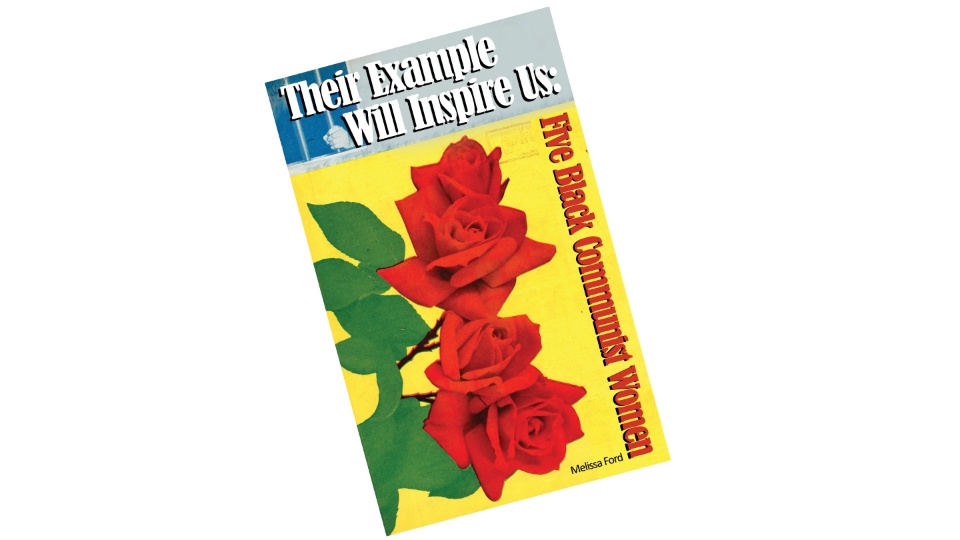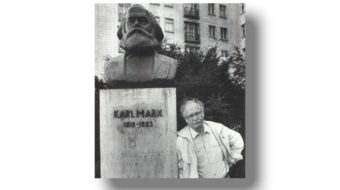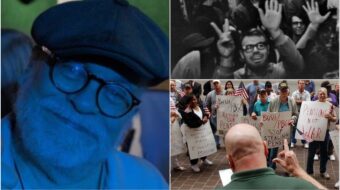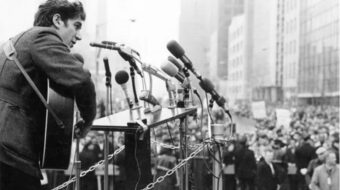
Historical amnesia, unfortunately, conditions much of our present consciousness. Dominant social institutions—media, schooling, and the political system—promote the deliberate habit of forgetting. This is especially true when it comes to our working-class history, the radical, even revolutionary struggles of workers against racism, exploitation, war, and the general submission to capitalist rule. Such institutionalized amnesia aims to disarm the oppressed and exploited in their struggle for power, even in their struggle to recognize each other in the community.
Occasionally, historians and writers publish new research that tries to correct the record, restore our memory, and affirm our heritage. One such effort is Melissa Ford’s Their Example Will Inspire Us. This five-chapter book studies the lives of five Black Communist women: Mattielee Woodson Hawkins, Romania Ferguson, Eleanor Rye-Broady, Edna Griffin, and Maude White Katz.
Mattielee Woodson Hawkins
I first heard of Mattielee Woodson Hawkins, the protagonist of the book’s first chapter, when I interviewed Black autoworker and communist Dave Moore a couple of years before his passing about his experiences during the founding of the UAW at Ford. He had been singlehandedly keeping her memory alive in the oral histories and interviews he had given since the 1980s. Despite the scarcity of archived records, Ford’s account, albeit tenuous and speculative at moments, helps restore her to modern readers and activists.
Like thousands of others, Mattielee Woodson Hawkins had participated in the Detroit Unemployed Councils with the onset of harsh deprivations, unemployment, and starvation during the Great Depression. She joined the Ford Hunger March in the late winter of 1932, which met with police violence against the marchers. Subsequently, she became instrumental in the union’s years-long campaign at Ford by mobilizing Black community support for the workers, leading to union anti-discrimination policies. She was among many Black leaders who helped to transform Detroit into a hotbed of radical and progressive working-class activism for labor, against racist oppression and anti-communist reaction.
Romania Ferguson
Chapter two is a sketch of Romania Ferguson, a Chicago labor activist, occasional Communist Party candidate for office, and National Negro Congress participant in the late 1920s through the mid-1940s. It may be the most uneven of the five chapters in the book. Ferguson first came into contact with the Communist Party during its earliest organizing drives with Chicago’s Black women food processing workers in 1926. Drawn into rigorous, exciting, and tempestuous organizing work, Ferguson’s enthusiasm and intellectual gifts earmarked her for further training at Brookwood Labor College in New York. She returned to Chicago to organize the city’s Black garment workers. In 1931, the Chicago communists endorsed and subsidized her two-plus years at the Communist International’s Moscow-based International Lenin School (ILS). I think Ford’s treatment of this period of Ferguson’s life needs more careful assessment.
As historian Brigitte Studer has shown in Travellers of the World Revolution, the ILS was specially designed to educate its students for “total engagement” in the world revolution as emissaries of the Communist International. The fact that the Chicago district endorsed Ferguson for this role signaled its deep respect for her capacities. Further, an ILS education ensured the successful graduate would be propelled to the Communist Party’s national leadership, shaping theory, policy, strategy, and tactics in line with the world revolution. It also meant the ILS graduate would likely live a life directed mainly by the Comintern bureau for which they worked—what Studer calls “a nomadic life,” always on the move and never settled in a single place. Ford doesn’t account for this aspect of Ferguson’s Moscow training. Ferguson’s decision to leave ILS early, having completed about two of the three planned years, may reflect her unwillingness to commit fully to such a difficult life.
Ferguson’s return to Chicago in 1933, Ford shows, saw her eagerly reenter labor organizing with some success, assisting Black apron makers at “Sopkin’s Sweat Shops” to join the Communist-led needle trades union. However, something happened in 1933 and 1934 to halt the effort’s momentum. Ford explores party records that reveal the district leadership attempted to secure scarce resources from the national office in 1934 to send Ferguson to a Party-affiliated, upstate New York recreational camp to help her recover from an illness. The letters from the Chicago district leaders to the national office show the district was deeply sympathetic to Ferguson’s situation.
Ford’s critical response to the district leadership’s assessments of Ferguson’s personality and personal problems as “none of their business” seems overstated. An organizer’s job description, especially for a semi-legal, state-targeted organization like the Communist Party in 1933, included personality traits such as trustworthiness, effective communication, and building and maintaining personal and organizational relationships. The fact that organizers commonly discussed one another’s personality and character, ironically, is well documented in most of the other chapters of Their Example Will Inspire Us.
Because the so-far uncovered evidence cannot reconstruct the details of this episode in Ferguson’s life, the author’s judgment seems ungenerous to the district leadership, who likely worried as much about their comrade’s health as they did for the organization’s security. Withholding speculation may have been better, without concrete evidence, about what happened to Romania Ferguson in 1933 and 1934. Later, Ferguson continued in her role in the party’s apparatus as an educator for its workers’ school and in popular front organizations such as the National Negro Congress. Ferguson’s party leadership trajectory, however, had ended.
Eleanor Rye Broady
Ford’s narrative skills are at their best in chapter three’s description of Eleanor Rye Broady’s work organizing Black steelworkers. It contains some of the book’s most dramatic episodes. Broady’s early career centered on organizing Chicago’s Black women steelworkers in 1936 into the party-founded Steelworkers Organizing Committee (SWOC). Broady worked via the union and the National Negro Congress, building labor and community alliances. An effective organizer and thinker, she continued to devote her efforts to the International Workers Order, the Civil Rights Congress, and writing for progressive Black publications after World War II. From Chicago, Broady moved first to Detroit and then to Southern California. She ultimately left the Communist Party in the 1950s.
The final two chapters are the most engrossing. Ford’s studies of Edna Griffin and Maude White Katz depict revolutionary Black women from different class backgrounds, geographical regions, and temperaments who devoted their lives to shaping or carrying out the Communist Party’s political program.

Edna Griffin
Griffin, a schoolteacher and spouse to a medical doctor, began her public role protesting racist violence and segregation as a student at Fisk University. Later, as a union activist, she “spent her years in New York as a passionate, committed teacher and labor and community organizer.” After a term of service in the Army WACs, she moved with her husband to Des Moines, Iowa, after the war. She opened her home as a center for organizing on behalf of the Wallace campaign in 1948, the defenses of W.E.B. Du Bois, the Rosenbergs, Paul Robeson, and Rosa Lee Ingram during the nadir of the Cold War. She strategized and led the campaign to end racist segregation in public spaces in Des Moines, including campaigns against racist police violence targeting Black workers and Black radicals. In the 1960s, she organized solidarity campaigns in Des Moines to support the civil rights struggles in the South, organized local antiwar and anti-nuclear weapons campaigns, and supported the candidacy of Shirley Chisholm for president in 1972.
Maude White Katz
Maude White Katz stands apart from the others in the book. More than most, her role in the Party’s leadership ran much deeper than even the author of this chapter suggests. Ford traces her trip to Moscow to study at the Communist University of the Toilers of the East from 1929 through 1931 alongside other future party leaders such as William Patterson. She witnessed the historic Sixth Congress of the Communist International, which established the Communist position on the national question. Though Ford presents only a partially accurate summary of the policy, she correctly notes its considerable impact on the Communist understanding of the role of racism under capitalism and how revolutionaries should fight it.
Upon returning to New York City, Maude White Katz played a pivotal role in shaping the Party’s response to the Depression. She strategized with other Party leaders and set about organizing the unemployed councils and leading public protests in that city, often, unfortunately, accompanied by horrific police violence against the workers. These actions set the tone for the Party’s national campaign to force national, state, and local governments to provide unemployment relief and welfare support for struggling workers.
Subsequently, Maude White Katz was instrumental in developing the Party’s internal campaign against white chauvinism in 1931. This impactful campaign resonated throughout the national organization, resulting in the expulsion of numerous Euro-American members engaged in racist practices. Ford’s solid chapter on her life has more stories about her unsung leadership and contributions.
Regrettably, this book, like many other historical accounts of Black communists, leaves an impression of Maude White Katz (along with similarly positioned Black leaders such as William Patterson or Claudia Jones) as outsiders within their own party, poking critically at a slowly changing organization. A more accurate assessment is that each was a decisive leader who shaped (and reshaped over time) Party policy and practices. Gerald Horne’s biography of William Patterson, Black Revolutionary, models the kind of book-length study of “the man who cried genocide” that Maude White Katz also deserves. Ford’s chapter-length account is an admirable basis for a more substantial biography.
The women depicted in Their Example Will Inspire Us had varying levels of political commitment, dividing their time between work, education, family, and public roles. They were closely connected to the labor movement as direct organizers or community allies. They developed Marxist understandings of class struggle that linked social processes in workplaces, political sites, and community locales. They emphasized the inseparability of the anti-racist struggle from working-class empowerment, and some, like Maude White Katz and Romania Ferguson, were instrumental in revamping the Communist Party’s theoretical and policy stances. Others, such as Edna Griffin and Eleanor Rye Broady, used their understanding of the U.S. racial capitalist reality to guide their daily work in the struggle. Their lives, ideas, and modes of leading or participating in struggles laid the foundations for how communists understand Marxist theory, strategy, and practical tactics for progressive or revolutionary change. Their Example Will Inspire Us might occasionally be somewhat controversial, but it does great justice to the legacy of these revolutionary figures.
Melissa Ford
Their Example Will Inspire Us: Five Black Communist Women
New York, International Publishers, 2024
$24.99
ISBN: 978-0-7178-0038-4
Order a copy here.
We hope you appreciated this article. At People’s World, we believe news and information should be free and accessible to all, but we need your help. Our journalism is free of corporate influence and paywalls because we are totally reader-supported. Only you, our readers and supporters, make this possible. If you enjoy reading People’s World and the stories we bring you, please support our work by donating or becoming a monthly sustainer today. Thank you!










